Geology 307: Igneous and Metamorphic Petrology (Spring 2015)
Item set
- Title
- Geology 307: Igneous and Metamorphic Petrology (Spring 2015)
- Creator
- Tamara Carley
- Date Created
- 22 January 2015
Items
-
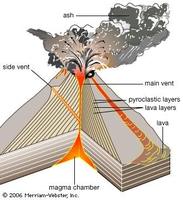 Stratovolcanoes (figure 1) are typical of these types of tectonic settings. These features are sourced by magma that is generated by the partial melting of the asthenosphere. Trenches (figure 2) form at the point of convergence between the subducting oceanic plate and the continental plate.
Stratovolcanoes (figure 1) are typical of these types of tectonic settings. These features are sourced by magma that is generated by the partial melting of the asthenosphere. Trenches (figure 2) form at the point of convergence between the subducting oceanic plate and the continental plate. -
 The arcs studied sit at a convergent margin where the oceanic slab subducts to a depth of approximately 200 km where the surrounding asthensophere partially melts due to a process called flux melting.
The arcs studied sit at a convergent margin where the oceanic slab subducts to a depth of approximately 200 km where the surrounding asthensophere partially melts due to a process called flux melting. -
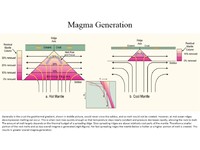
-
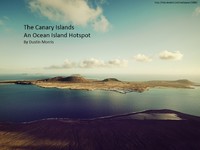 A description and analysis of the tectonic setting, landforms, magmatic processes, geochemistry of the Canary Island Ocean Island Basalts
A description and analysis of the tectonic setting, landforms, magmatic processes, geochemistry of the Canary Island Ocean Island Basalts -
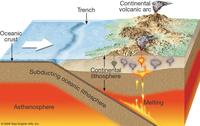 As the oceanic lithosphere subducts at a convergent margin, it dehydrates. The water then moves into the adjacent upper mantle. The “wet” mantle melts at a lower temperature than the dry, allowing magma to form given the geothermal conditions. The melting point of normal "dry" mantle does not intersect the geothermal gradient at the depth of magma formation. Therefore, to melting to occur, water must be introduced into the system. This process is known as flux melting. In the Cascades, The Juan de Fuca plate is subducting under the North American plate. The water from the Juan de Fuca plate is transferred to the mantle under the North American plate causing magma to form.
As the oceanic lithosphere subducts at a convergent margin, it dehydrates. The water then moves into the adjacent upper mantle. The “wet” mantle melts at a lower temperature than the dry, allowing magma to form given the geothermal conditions. The melting point of normal "dry" mantle does not intersect the geothermal gradient at the depth of magma formation. Therefore, to melting to occur, water must be introduced into the system. This process is known as flux melting. In the Cascades, The Juan de Fuca plate is subducting under the North American plate. The water from the Juan de Fuca plate is transferred to the mantle under the North American plate causing magma to form. -
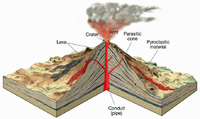 Convergent margins generally form linear volcanic belts with stratovolcanoes. Stratovolcanoes form due in part to the high viscosity of the magma. On the oceanic side of the convergence, trenches often form from the subduction of the oceanic lithosphere. The Cascades have large mountains and volcanoes throughout the range. Glass mountain is one of the taller peaks in California; it consists of lava domes and flows. Medicine Lake Volcano is a more shield shaped volcano. It erupted most recently 950 year ago. The composition ranges from basaltic to rhyolitic Mount Rainier is found in Washington and is the highest mountain of the cascades. It is a stratovolcano which is still active.
Convergent margins generally form linear volcanic belts with stratovolcanoes. Stratovolcanoes form due in part to the high viscosity of the magma. On the oceanic side of the convergence, trenches often form from the subduction of the oceanic lithosphere. The Cascades have large mountains and volcanoes throughout the range. Glass mountain is one of the taller peaks in California; it consists of lava domes and flows. Medicine Lake Volcano is a more shield shaped volcano. It erupted most recently 950 year ago. The composition ranges from basaltic to rhyolitic Mount Rainier is found in Washington and is the highest mountain of the cascades. It is a stratovolcano which is still active. -
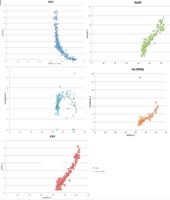 Harker Diagram - The Harker Diagram (Figure 1) shows that the Ocean Island Basalts of the St. Helena Chain show a decreasing concentration in compatible elements (i.e. Magnesium) coincided with a relative increase in the concentration of incompatible elements (i.e. Potassium and Ytterbium). This suggest that the magma sourced was less primitive, evolving over time as it ascended through the mantle.
Harker Diagram - The Harker Diagram (Figure 1) shows that the Ocean Island Basalts of the St. Helena Chain show a decreasing concentration in compatible elements (i.e. Magnesium) coincided with a relative increase in the concentration of incompatible elements (i.e. Potassium and Ytterbium). This suggest that the magma sourced was less primitive, evolving over time as it ascended through the mantle. -
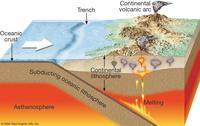 Convergent margins occur when two plates come together, oftentimes with one plate subducting under the other. In the case of the Cascades, the Juan de Fuca plate is subducting under the North American Plate. The magma is generally sourced from the upper mantle.
Convergent margins occur when two plates come together, oftentimes with one plate subducting under the other. In the case of the Cascades, the Juan de Fuca plate is subducting under the North American Plate. The magma is generally sourced from the upper mantle. -
 Ocean Islands tend to have globally consistent land forms that vary in composition and size on an individual basis. Islands are formed by the constant replenishment of fresh material over a local volcanic vent, these formations are known as shield volcanoes (Figure 1). Figure 2 represents a typical cross-section of an individual laval flow.
Ocean Islands tend to have globally consistent land forms that vary in composition and size on an individual basis. Islands are formed by the constant replenishment of fresh material over a local volcanic vent, these formations are known as shield volcanoes (Figure 1). Figure 2 represents a typical cross-section of an individual laval flow. -
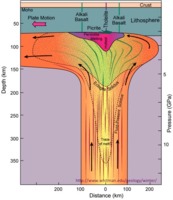 Ocean island basalts (OIB's), such as the St. Helena Chain, sit on an oceanic plate that glides over a stationary hotspot. The hot spot (Figure 1) is sourced from the deep mantle near the Core - Mantle Boundary (approximately 3,000 km. depth). Figure 2 depicts the geothermal gradient under normal conditions where there is no magma being generated. Under observed conditions, the stationary Hot Spot increases local temperatures at constant pressures allowing for the generation of magma. This magma eventually works its way to the surface by processes such as doming, wall rock assimilation, lateral wall rock displacement, and ductile wall rock deformation.
Ocean island basalts (OIB's), such as the St. Helena Chain, sit on an oceanic plate that glides over a stationary hotspot. The hot spot (Figure 1) is sourced from the deep mantle near the Core - Mantle Boundary (approximately 3,000 km. depth). Figure 2 depicts the geothermal gradient under normal conditions where there is no magma being generated. Under observed conditions, the stationary Hot Spot increases local temperatures at constant pressures allowing for the generation of magma. This magma eventually works its way to the surface by processes such as doming, wall rock assimilation, lateral wall rock displacement, and ductile wall rock deformation. -
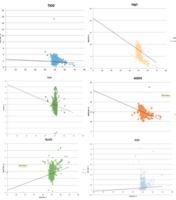 Harker Diagram - This figure depicts the concentrations of variable elements. Through the figure, we can infer relative compatibility and incompatibility. As discussed earlier, MORB's are sourced from the depleted (in incompatible elements) upper mantle. This means that we should see a strong concentration of compatibles relative to incompatibles. As seen in the Harker Diagram provided, MORB's are rich in compatible components such as: Iron, Magnesium, and Sodium. Of these elements, Magnesium is the most compatible and Sodium is the least compatible.
Harker Diagram - This figure depicts the concentrations of variable elements. Through the figure, we can infer relative compatibility and incompatibility. As discussed earlier, MORB's are sourced from the depleted (in incompatible elements) upper mantle. This means that we should see a strong concentration of compatibles relative to incompatibles. As seen in the Harker Diagram provided, MORB's are rich in compatible components such as: Iron, Magnesium, and Sodium. Of these elements, Magnesium is the most compatible and Sodium is the least compatible. -
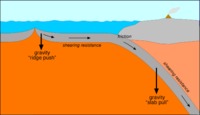 There are various factors which cause magma to form at mid-ocean ridges. The growing bulk of the ridge pushes the rest of the tectonic plate away from the center of the ridge. The weight of the plate subducting pulls the plate down, dragging the entire plate away from the ridge. This is known as slab pull The combination of ridge push and slab pull cause a low pressure zone at the spreading center. The low pressure paired with the heat of the area allows the upper mantle to melt. The upper mantle is a depleted source and the resulting magma is highly evolved.
There are various factors which cause magma to form at mid-ocean ridges. The growing bulk of the ridge pushes the rest of the tectonic plate away from the center of the ridge. The weight of the plate subducting pulls the plate down, dragging the entire plate away from the ridge. This is known as slab pull The combination of ridge push and slab pull cause a low pressure zone at the spreading center. The low pressure paired with the heat of the area allows the upper mantle to melt. The upper mantle is a depleted source and the resulting magma is highly evolved. -
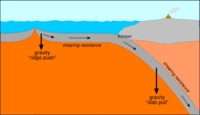 There are various factors which cause magma to form at mid-ocean ridges. The growing bulk of the ridge pushes the rest of the tectonic plate away from the center of the ridge. The weight of the plate subducting pulls the plate down, dragging the entire plate away from the ridge. This is known as slab pull The combination of ridge push and slab pull cause a low pressure zone at the spreading center. The low pressure paired with the heat of the area allows the upper mantle to melt. The upper mantle is a depleted source and the resulting magma is highly evolved.
There are various factors which cause magma to form at mid-ocean ridges. The growing bulk of the ridge pushes the rest of the tectonic plate away from the center of the ridge. The weight of the plate subducting pulls the plate down, dragging the entire plate away from the ridge. This is known as slab pull The combination of ridge push and slab pull cause a low pressure zone at the spreading center. The low pressure paired with the heat of the area allows the upper mantle to melt. The upper mantle is a depleted source and the resulting magma is highly evolved. -
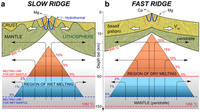 Landforms are dependent of the spreading rate of a local ridge. At fast spreading centers, volcanism occurs more frequently and covers a larger eruptive area. Due to a near constant refreshment of molten material, the flanks of the ridge are much smoother than slower ridges as well as symmetric and less tectonically disrupted fissures. Because there is a larger volume of magma being produced, compositional trends less diverse than slower ridges.
Landforms are dependent of the spreading rate of a local ridge. At fast spreading centers, volcanism occurs more frequently and covers a larger eruptive area. Due to a near constant refreshment of molten material, the flanks of the ridge are much smoother than slower ridges as well as symmetric and less tectonically disrupted fissures. Because there is a larger volume of magma being produced, compositional trends less diverse than slower ridges. -
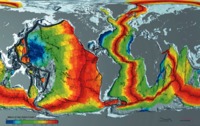 Tectonic Setting - Located between two oceanic plates, a ridge forms where these plates diverge from each other, creating a spreading center. The rates of spreading are variable and impact what landforms dominate. Magmatic Setting - Volcanism occurs at the spreading center and is variable with spreading rate. Faster spreading ocean ridges tend to have less localized point-source volcanism.
Tectonic Setting - Located between two oceanic plates, a ridge forms where these plates diverge from each other, creating a spreading center. The rates of spreading are variable and impact what landforms dominate. Magmatic Setting - Volcanism occurs at the spreading center and is variable with spreading rate. Faster spreading ocean ridges tend to have less localized point-source volcanism. -
 The St. Helena Chain is an underwater chain of islands located in the southern Atlantic Ocean situated on the African Plate with a general Northeast trending direction of motion at a rate varying between 2 to 4 cm/yr.
The St. Helena Chain is an underwater chain of islands located in the southern Atlantic Ocean situated on the African Plate with a general Northeast trending direction of motion at a rate varying between 2 to 4 cm/yr. -
There are two of spreading ridges: slow and fast.
-
 The Macdonald Seamount lies above the Macdonald Hotspot in the Austral Islands. It last erupted in 1989. Less is known about the Arago Seamount, as it was only discovered in 2002.
The Macdonald Seamount lies above the Macdonald Hotspot in the Austral Islands. It last erupted in 1989. Less is known about the Arago Seamount, as it was only discovered in 2002. -
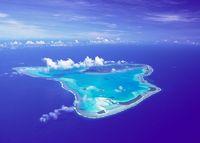 The Cook Islands has 6 atolls, or sunken volcanoes surrounded by coral reefs. These are Aitutaki, Manihiki, Palmerston Island, Penrhyn, Pukapuka, and Rakahanga.
The Cook Islands has 6 atolls, or sunken volcanoes surrounded by coral reefs. These are Aitutaki, Manihiki, Palmerston Island, Penrhyn, Pukapuka, and Rakahanga. -
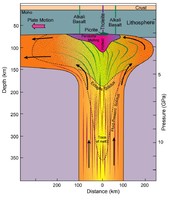 This cross-section of a mantle plume is representative of the offshoots of the superplume that created the Austral-Cook Islands. Mantle plumes originate as masses of heat and solid rock from the core-mantle boundary, potentially as the result of a subducted plate reaching the D' Layer. At shallower depths, they begin to melt in three phases, as shown on the diagram. The edges of the plume are more alkaline than the tholeiitic interior. This difference is due to the extent of melting on the edge of the plume, which is cooler due to heat loss with the surrounding country rock versus the hot interior of the plume. Because there is a lower melt fraction at the edges of the plume, it tends to be richer in incompatible elements, which are quick to escape from a melt.
This cross-section of a mantle plume is representative of the offshoots of the superplume that created the Austral-Cook Islands. Mantle plumes originate as masses of heat and solid rock from the core-mantle boundary, potentially as the result of a subducted plate reaching the D' Layer. At shallower depths, they begin to melt in three phases, as shown on the diagram. The edges of the plume are more alkaline than the tholeiitic interior. This difference is due to the extent of melting on the edge of the plume, which is cooler due to heat loss with the surrounding country rock versus the hot interior of the plume. Because there is a lower melt fraction at the edges of the plume, it tends to be richer in incompatible elements, which are quick to escape from a melt. -
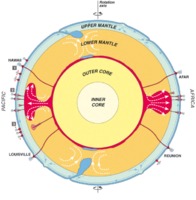 Diagram showing the three types of mantle plumes. The Austral-Cook volcanic chain is sourced from the superplume shown under the Pacific Ocean. These plumes are broad and tend to stall in the upper mantle. There, they spawn into a series of smaller heterogeneous plumes, which are the expressions we see at the surface.
Diagram showing the three types of mantle plumes. The Austral-Cook volcanic chain is sourced from the superplume shown under the Pacific Ocean. These plumes are broad and tend to stall in the upper mantle. There, they spawn into a series of smaller heterogeneous plumes, which are the expressions we see at the surface. -
The Austral-Cook volcanic chain formed as the result of three distinct hotspots in the South Pacific active since 35 Ma (Bonneville et al., 2002) The Arago Seamount is the most recent surface expression of hotspot volcanism, and is responsible for forming islands in the center of the chain, such as Rurutu. The Macdonald Hotspot had a southeast movement, and formed the southern islands. An extinct magma source, therefore, must be responsible for the formation of the northern Austral Islands. (Bonneville et al., 2002). The ages of deposits across the volcanic chain suggest that the hotspots were once active at the same time. Therefore, Bonneville et al. (2002) suggest that magma here was likely sourced by magma from the upper mantle that upwelled due to lithospheric weakness. Bonneville et al. (2005) suggest that the chemical similarity of these three hotspot deposits is because the three hotspots come from the same "superplume" that originates at the core-mantle boundary.
-
 Austral Cook OIB data
Austral Cook OIB data -
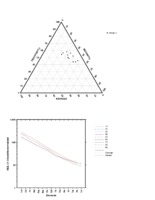 Geochemical Plots for the Austral-Cook Ocean Island Arc. Includes Spider Diagram, REE plot, and ternary diagrams. Click each file for a detailed interpretation of the data.
Geochemical Plots for the Austral-Cook Ocean Island Arc. Includes Spider Diagram, REE plot, and ternary diagrams. Click each file for a detailed interpretation of the data. -
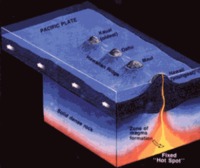 The Cape Verde Islands were formed through hotspot volcanism. This means that mantle plumes, which originated at the mantle core boundary, rise to the surface, entraining with them undepleted, or fertile mantle. As the oceanic plate moves, the hotspot will stay in the same place. This will create a chain of volcanic landforms. The chain will show the history and movement of the plate. The volcanoes created at a hotspot are shield volcanoes. Shield volcanoes can be extremely large landforms, some containing in excess of 40,000 km3 in volume (Winter, 56). Shield volcanoes are very shallow sloping, usually 3-10 degrees in slope (Winter, 56). The largest of the Cape Verde Islands is called Fogo. This island is a large shield volcano that has been erupting for the last 20 million years (Young). Winter, J. D. (2010). Principals of Igneous and Metamorphic Petrology. New Saddle River, NJ: Pearson Education, Inc. (pp. 5, 385-387, 455). Image from: Young, J. Cape Verde’s Eruption: An Example of Hotspot Volcanism. 1 Dec 2014. http://www.decodedscience.com/cape-verdes-eruption-example-hotspot-volcanism/51069
The Cape Verde Islands were formed through hotspot volcanism. This means that mantle plumes, which originated at the mantle core boundary, rise to the surface, entraining with them undepleted, or fertile mantle. As the oceanic plate moves, the hotspot will stay in the same place. This will create a chain of volcanic landforms. The chain will show the history and movement of the plate. The volcanoes created at a hotspot are shield volcanoes. Shield volcanoes can be extremely large landforms, some containing in excess of 40,000 km3 in volume (Winter, 56). Shield volcanoes are very shallow sloping, usually 3-10 degrees in slope (Winter, 56). The largest of the Cape Verde Islands is called Fogo. This island is a large shield volcano that has been erupting for the last 20 million years (Young). Winter, J. D. (2010). Principals of Igneous and Metamorphic Petrology. New Saddle River, NJ: Pearson Education, Inc. (pp. 5, 385-387, 455). Image from: Young, J. Cape Verde’s Eruption: An Example of Hotspot Volcanism. 1 Dec 2014. http://www.decodedscience.com/cape-verdes-eruption-example-hotspot-volcanism/51069
